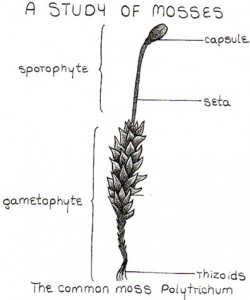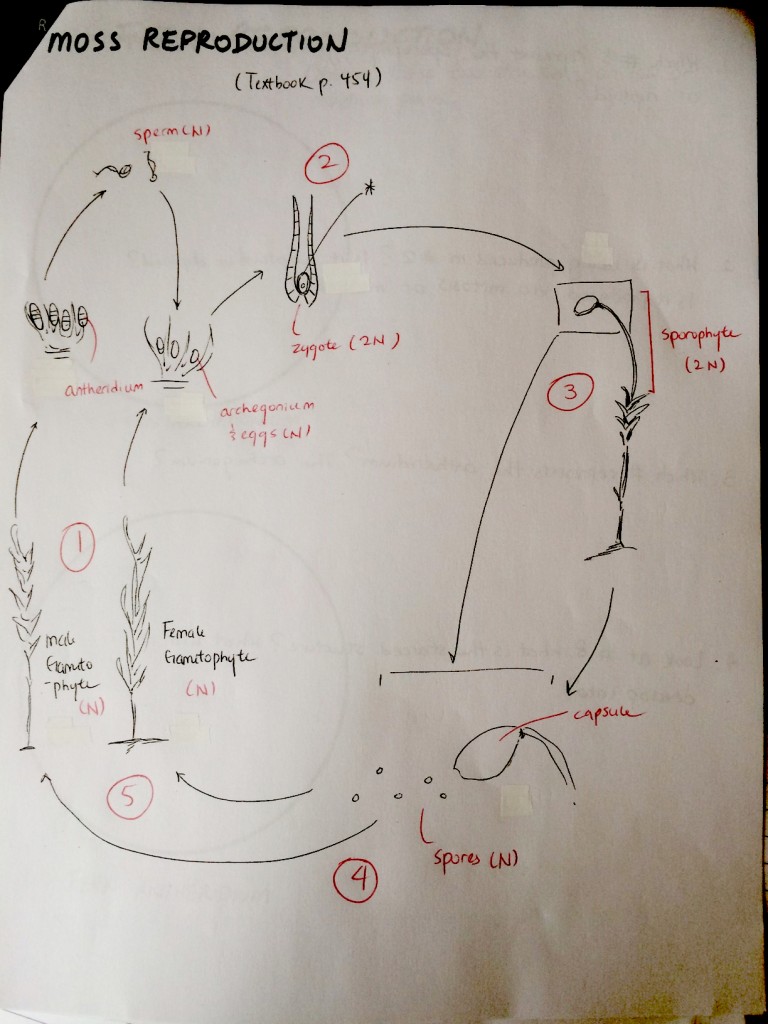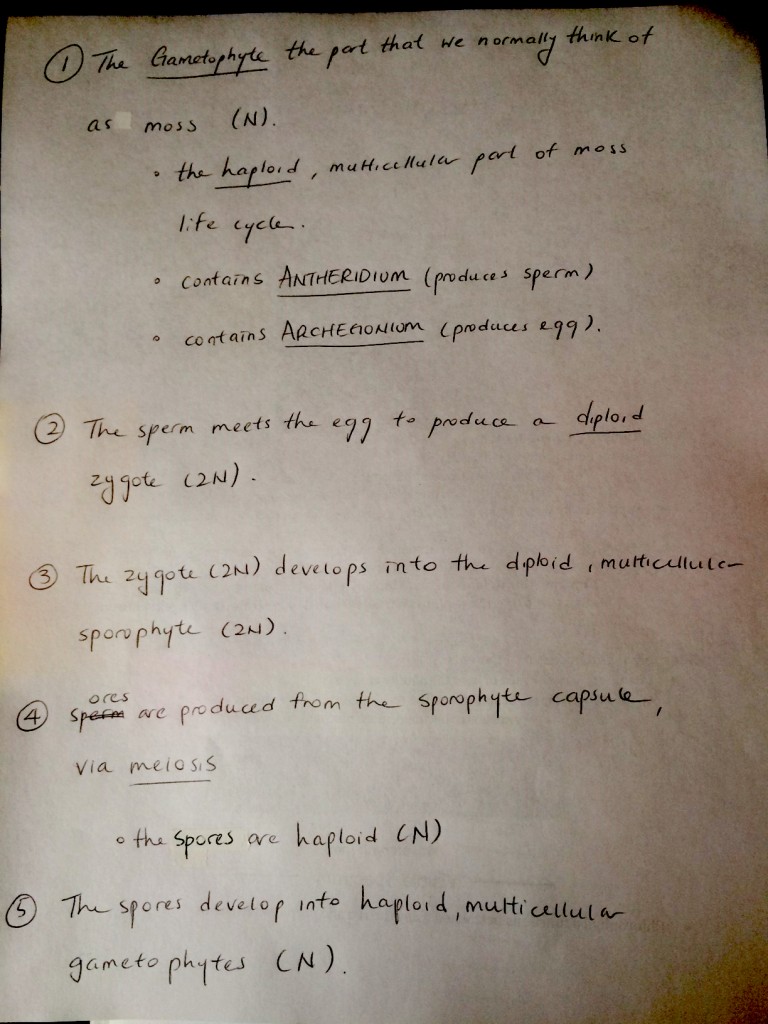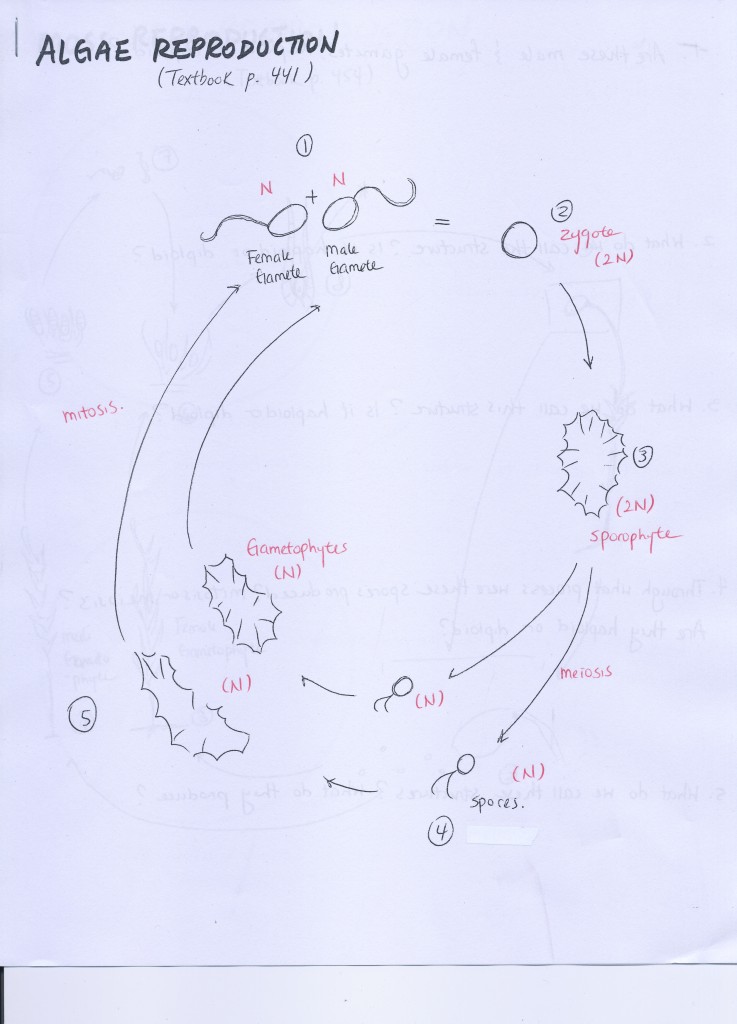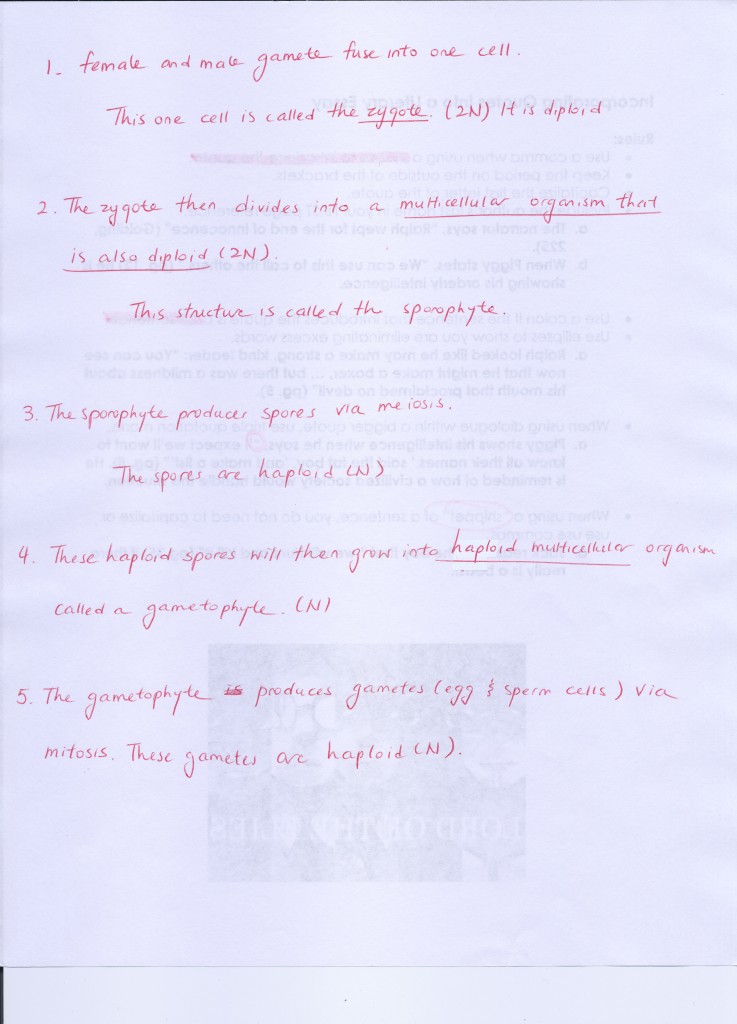Category Archives: Plant
Jeopardy (Kingdom Plantae Review)
Angiosperms (Flowering Plants)
Block A (Adel, Katie and Alexis)
Presentation: Angiosperm
Review Sheet: Angiosperm Review Sheet
Block C (Michelle, Josie, Sydney, Aliyah, Kanta, Narmin, Megan)
Presentation: Angiosperm Presentation
Game: Jeopardy
Review Sheet: Angiosperm Review Sheet
Worksheet (and answers): Angiosperm Worksheet Angiosperm Worksheet Answers
Angiosperm (Summary)
(Adapted from Miller and Levine, 473) As the “flowering plants”, all angiosperms reproduce sexually through their flowers. Unlike the gymnosperms, the seeds of angiosperms are not “naked”, but carried in a protective wall (ovary) that will later develop into the fruit.
Structure and Function
Flowers have many of the adaptations that make it well suited for life on dry land, including:
- Cuticle
- Vascular tissue
- Seed coat
- Pollen grain
- Fruits and Flowers
The adaptation that makes angiosperms unique from all other plant groups we have discussed so far is the flower, the part responsible for sexual reproduction. Some angiosperms have male and female parts on separate flowers, while some angiosperms have both male and female parts on the same flower.
 The Stamen is the male reproductive organ of the flower. It includes the
The Stamen is the male reproductive organ of the flower. It includes the
- Anther: contains the microsporangia (microspore mother cells) where microspores are produced.
- Filament: long thin stalk that holds up the anther
The Carpel is the female reproductive organ of the flower. It includes the
- Stigma: the sticky part where pollen grain attaches
- Style: holds up the stigma
- Ovary: holds the ovule(s). Will eventually develop into the fruit.
The ovules is the site of double fertilization, a process unique to angiosperms. It will eventually develop into the seed.
Examples


Angiosperms make up the grand majority of plants in the world today. Whereas during the time of the dinosaurs, conifers were the dominant group, angiosperms rule the world today. Here are just several examples of all the angiosperms we have:
- All fruit trees
- Grasses
- Berries
- Deciduous trees
- Tulips, roses, etc.
- Rice, corn and grains
Reproductive Cycle
The beautiful diagram to the left (courtesy of Team Angiosperm block C), includes more detail than you are required to know. Nevertheless, it is an informative diagram that should help you in understanding the angiosperm life cycle.
Steps in the Reproductive Cycle
- The Sporophyte generation is represented by the plant itself, and the flower. The flower contains the anther and ovule(s).
- The anther contains many diploid microspore mother cells, which will then divide via meiosis to create microspores, which become the pollen grains. The pollen grains will then develop into sperm when it reaches the ovule.
- Microspore mother cell (2N) —> Microspores (N) —> Pollen grains (N) —> Sperm (N)
- Each ovule (contained within the ovary) contains one megaspore mother cell (2N), which will then divide via meiosis to produce a total of eight haploid cells. These eight haploid cells and the membrane that surrounds it is the embryo sac. Five of the haploid cells will disappear, two of them will become the polar nuclei, and one will become the egg cell.
- Megaspore mother cell (2N) –> Embryo sac (8 haploid cells + membrane) –> Polar nuclei (2N) and egg (N)
(Fertilization) Both the polar nuclei and egg will be fertilized by the sperm- The polar nuclei will become a triploid structure (3N) called the endosperm, it provides the nutrition for the developing embryo
- The egg and sperm will become a diploid structure (2N) called the zygote, which will develop into the embryo.
Gymnosperms (Focus on Conifers)
Block A (Allison M., Ryan)
Block C (Cassy, Kaitlyn, Kyle, Alex, Pavel)
Jeopardy 2.0 (1)
Biology Conifers
Conifer (Summary)
Conifer, the “cone-bearers”, are another member of phylum Tracheophyta. Amongst the five groups we are studying, conifers and angiosperms are also known as the seed plants. These plants have developed several adaptations that allowed them to become even more independent from water than the ferns, moss and algae, including seeds (structures that enclose and protect the embryo from drying), pollen grains (structures that enclose the sperm). You will notice in both conifers and angiosperms that the gametophyte generation is very small and reduced, and confined in the sporophyte.
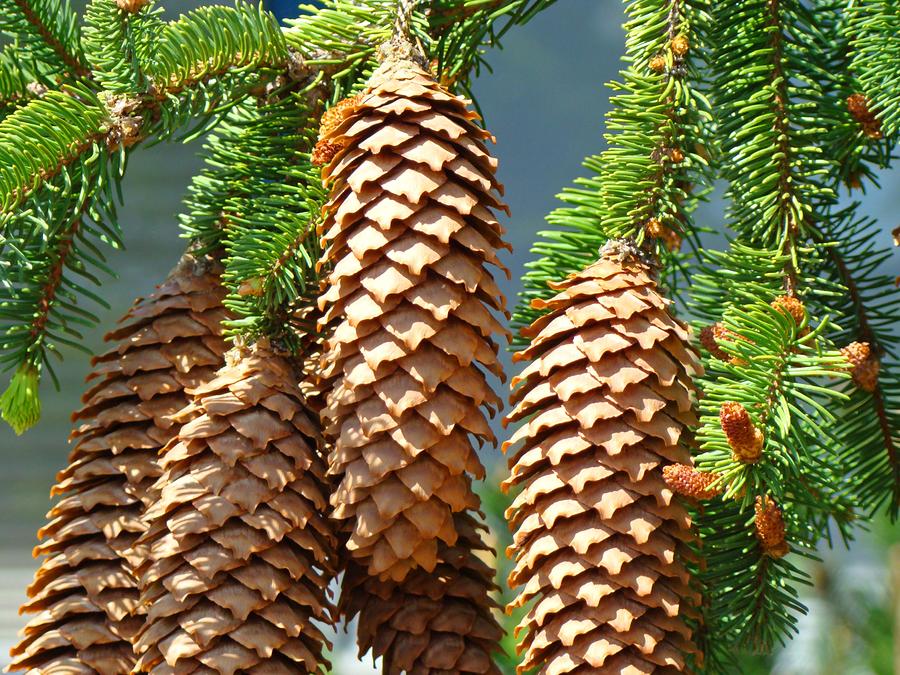
Structure and Functions Conifer and Angiosperm Reproduction
- Roots – true roots. For water and nutrient absorption.
- Stems – hold up leaves to the sun
- Leaves – needles, for photosynthesis and gas exchange
- Cuticle – protects the leaves from drying out. In some species of conifers, the cuticle is especially thick to protect the plant from very dry conditions
- Vascular Tissue (xylem and phloem) see below for details
Unique to conifers
- Cones – the reproductive structures of conifers. The site where the spore, gametophyte and gamete and zygote generations take place.
- Needle-like leaves – leaves that are rolled up into needles. This reduces the surface area and therefore, the amount of water loss. This is an adaptation for dry conditions.
Reproduction
Powerpoint: Conifer and Angiosperm Reproduction
The Powerpoint above explains in detail the stages of conifer reproduction. I highly recommend giving it a second look.
- The sporophyte (diploid, multicellular) generation of conifers is the tree itself.
- The sporophyte produces
- Male cones – contains the microsporangium
- Female cones – contains the megasporangium
- The microsporangium produces the microspores via meiosis. The megasporangium produces the megaspores vias meiosis. The megaspores and microspores are the spores generation of conifers.
- The megaspores then develop into ovules. The microspores develop into the pollen grain. These structures represent the gametophyte generation of conifers.
- The ovules produce the eggs. The pollen grain produce the sperm. These structures represent the gamete generation of conifers.
- The egg and the sperm combine to produce a diploid cell, the zygote, which will then develop into the multicellular sporophyte.
Answers to Algae, Moss, Ferns
Monocotyledons vs. Dicotyledons
Powerpoint: Monocotyledon and Dicotyledon
Lab: Dicotyledon and Monocotyledon Lab
Dicotyledon and monocotyledons are subclasses of class angiospermae (the flowering plants). These two subclasses of plants share the characteristics of flowering plants (flower, seed, fruit, stem, vascular tissue etc.). While they are named after the number of “seed leaves” that sprout from the growing plant (one for monocots and two for dicots), mature plants differ in many other respects (Table 1).
This lab, you will be trying identify several specimens as monocots or dicots based on some of the following characteristics.
Background on Angiosperm Reproduction
Angiosperm reproduction involves the meeting of sperm and egg. However, an extra step occurs in angiosperms that does not occur in any other plant group: a second sperm fuses with the polar nuclei to form a triploid structure, known as the endosperm (3N).
In most plants, the endosperm provides the “food store” for the developing embryo (2N).

The endosperm also does something very strange, it will give rise to the “seed leaves” known as the cotyledon. Because the endosperm is triploid (3N), the cotyledon is also triploid.
Depending on if there is one triploid seed leaf or two triploid seed leaves, the plant is classified as a “monocotyledon” (“one seed-leaf”) or “dicotyledon” (“two seed leaves”).

However, the cotyledon will eventually wilt away. Then there shall be no signs that indicate whether a plant is a monocot or a dicot right? Thankfully, not. There are many other signs to indicate whether a plant in its adult stage is a dicot or a monocot. We will be looking at five.
1. Leaves
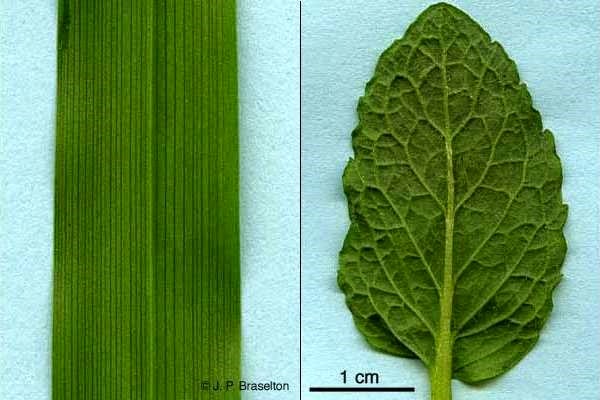
The veins of monocot leaves are usually straight and parallel.
The veins of dicot leaves usually form a branching network.
2. Stem and Root

Stem: (Monocots) The vascular tissues are scattered across the cross section. (Dicots) the vascular tissues are arranged in a ring under the epidermis.
Root: (Monocots) The vascular tissues are arranged in a ring (Dicots) the vascular tissues are bunched together into the center. The xylems are arranged in a tiny “X” in the dead middle.
3. Flowers

Monocot flowers usually have petals in multiples of 3’s.
Dicot flowers tend to have petals arranged in multiples of 4’s and 5’s.
4. Growth


Monocots stems usually do not grow thicker from year to year.
Dicot stems do usually grow thicker from year to year.
Practice: Try identifying the plants below as dicot or monocot! (Answers below)
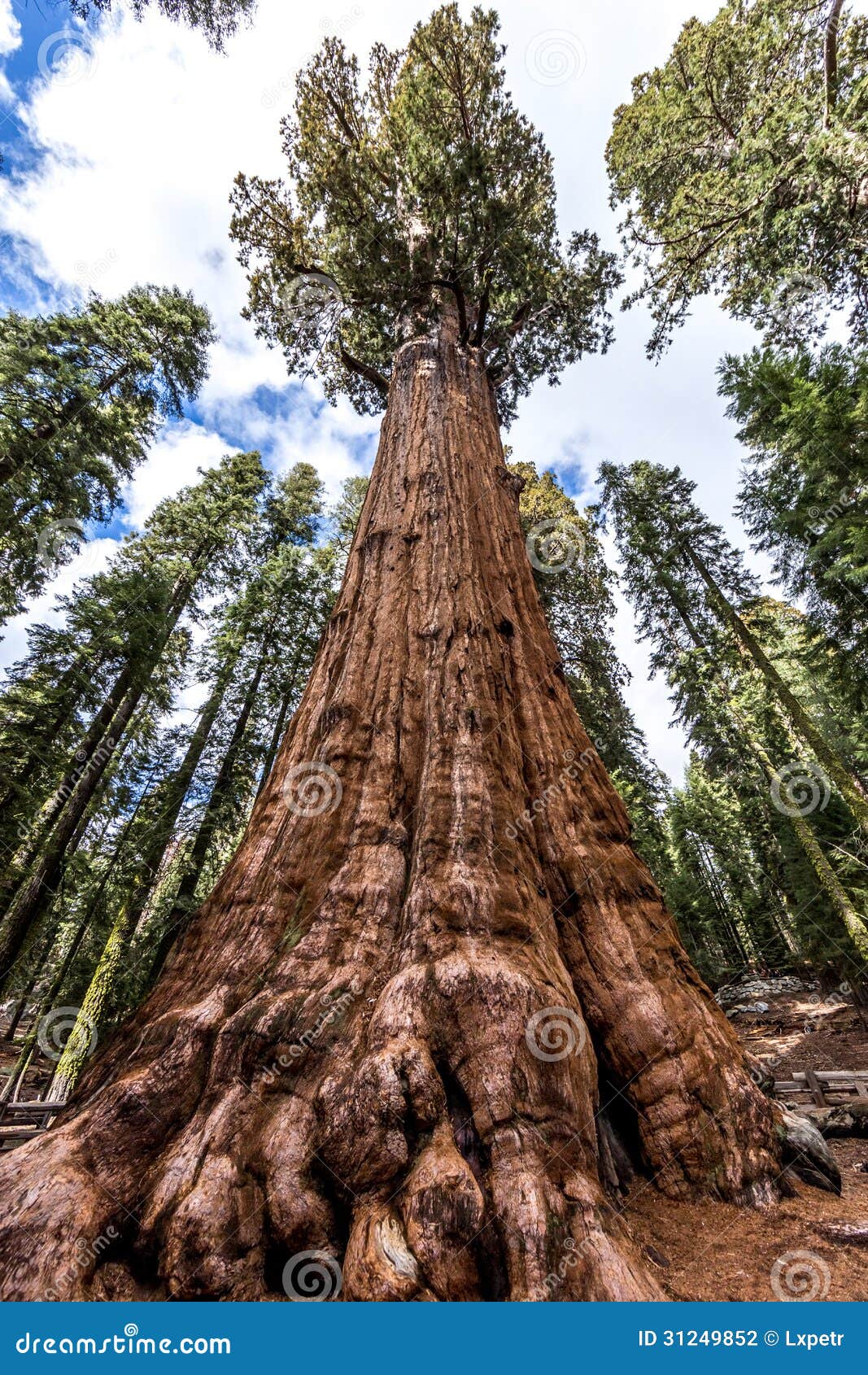 A (Tree)
A (Tree)
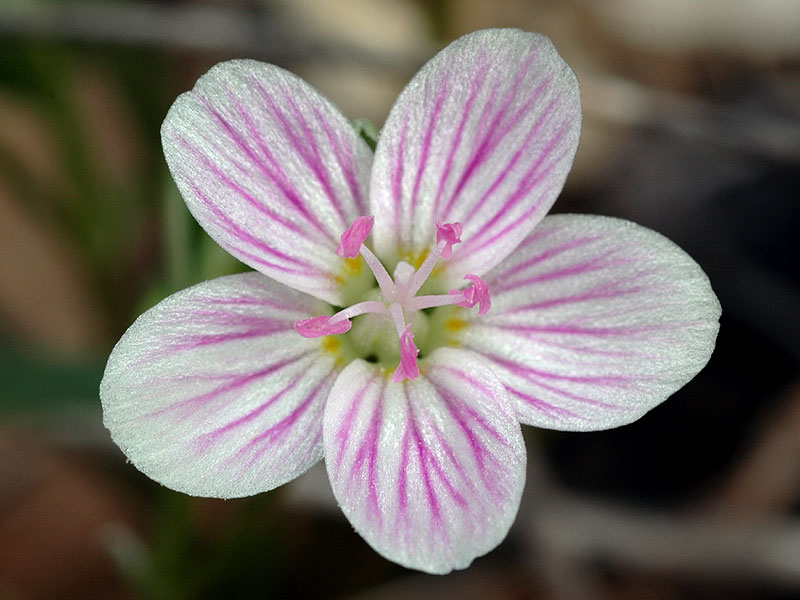 B (Flower)
B (Flower)
 C (Blade of Grass)
C (Blade of Grass)
 D (Palm Leaf)
D (Palm Leaf)
E (Fern)
 F (carrot cross section)
F (carrot cross section)
 G (Celery Cross section)
G (Celery Cross section)
Monocotyledon and Dicotyledon (Answers to Practice)
Ferns
Block A (Alex, Brenda and Julia)
Presentation: Ferns
Jeopardy Game: Jeopardy
Block C (Riley, Meaghen, Maya, Brittney, Paisley and Sierra)
Presentation: Fern Structure and Functions (Block C)
Review Sheet with Answers: Fern Review Sheet Questions answers.
Pteropsida (Ferns) (Summary)
Pteropsida, the ferns, are one of the first plants to have developed vascular tissue (xylem and phloem). Plants with vascular tissue are part of phylum Tracheophyta. These vascular tissue allow water, nutrients and sugars to be transported around the plant, allowing the plant to grow away from water and grow taller. Therefore, plants with vascular tissue are considered “true” land plants. However, as we will see, ferns are still somewhat dependent on water, as they still require water for reproduction.
Structure and Function

- Frond – the visible part of the plant, the leaves. Note that unlike in algae and moss, these fronds are considered true leaves, since they have vascular tissue
- Rhizome – creeping underground stems. (Note: RHIZOMES ARE NOT THE ROOTS OF FERNS) they are stems, their job is to anchor the fern to the ground.
- Roots – true roots. For water and nutrient absorption.
- Cuticle – a waxy layer on the top of leaves that help it to retain water
- Vascular Tissue
- Xylem – transports water and nutrients upwards
- Phloem – transports sugars up and down to everywhere the plant needs to go
- Sorus (pl. Sori) – dots found on the underside of fronds. They are defined as a cluster of many many sporangia (sing. sporangium). These sporangia produce spores
Sori on the underside of the fern.
Fern Reproduction
- The prothallus is the gametophyte (haploid, multicellular) stage of the fern life cycle. It is very small and rarely seen. On the underside, are the
- Antheridium: produces sperm cells (N)
- Archegonium: produces egg cells (N)
- Egg (N) fuses with sperm (N), creating zygote (2N). The zygote develops into multicellular embryo (2N), which then develops into the sporophyte. The sporophyte stage is the stage which we think of as “ferns”
- Sporophyte (2N) contains Sori, on its underside, which are clusters of sporangia.
- Each sporangium is responsible for producing spores via meiosis. The spores are therefore haploid.
- The spores (N) develop into the haploid multicellular gametophyte: the prothallus.
Mosses
Block A (Cassidy, Lexus, Allison, Ana and Logan)
Presentation: Moss (Block A)
Moss Review Sheet- Biology 11 (1)
Block C (Dylan, Kyle, Nathan, Jake, and Ryan)
Presentation: block c Moss project
Mosses (Summary)
Bryophyta (including mosses, hornworts and liverworts) are a group of primitive plants that probably resembled the first plants to colonize the land. However, they are not considered land plants, since they are still highly dependent on water to thrive. Here, we will focus on the mosses.
Structure and Function
Mosses, like the algae from which they evolved, display alternation of generations. This means that in one complete life cycle, it has a diploid, multicellular generation (sporophyte) and a haploid, multicellular generation (gametophyte).
They are adapted to moist environments with plentiful rainfall at least part of the year. Therefore, mosses…
- Have no vascular tissue
- No leaf, root or stem, since it has no vascular tissue
- It has rhizoids, which are “root-like” structures that do not suck up nutrients or water, but anchor the plant to the surface it is on
- No cuticle
- Flagellated sperm cells that swim through water to fertilize eggs
- The green part of the plant that we really think of as moss is the gametophyte. And like all gametophytes…
- It is haploid (N)
- It produces gametes: eggs (in the archegonium) and sperm (in the antheridium)
- If you look closely at mosses, you may see a small stalk with a capsule on the end sticking out of the green mass. That is the sporophyte.
- It is diploid (2N)
- It is produced from the fusion of egg ans sperm
- It produces spores via meiosis
- Therefore, the spores that are produced are haploid (N)
Algae (Phylum Chrysophyta)

Block A (Megan, Jacob, Teigen, Aiden and Alaiah)
Bio 11 project Teigen Slides
Algae Review Game
Algae Review Sheet Answer key (2)
Block C (Anton, Denisa, Princess, Shereen, Erik, Kiyano)
https://prezi.com/ktpb0sucdidk/edit/#74_43012735
Review Sheet: Answer Key (1)
Chrysophyta (Summary)
Algae are amongst the oldest organisms in the world. Their physiology are similar to the organisms that likely gave rise to all plants today, from the great oak to the little moss. Giant kelp forests serve as the basis for large oceanic ecosystems. They produce almost half the oxygen in the atmosphere. Without algae, life on earth as we know it would not exist.
Learning Objectives
- Identify the structure of green algae
- Explain the function of the structures for adapting to their environment
- Identify examples of Chlorophyta
- Describe the reproductive life cycle of Ulva spp. (Multicellular algae)
- Identify the sporophyte and gametophyte
- Identify whether each stage of the life cycle is haploid or diploid
Structure and Function
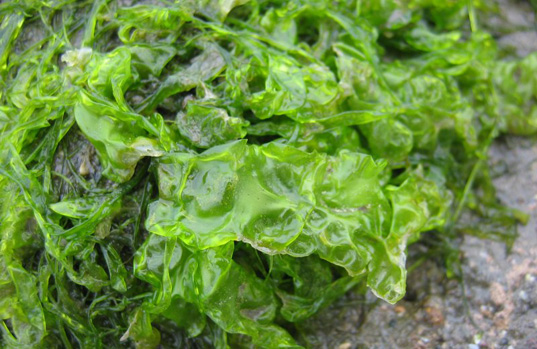
Algae come in a variety of color, shapes and sizes. There are unicellular, colonial (many individuals living together, but no specialization) or multicellular (specialized structures).
As water-based organisms, algae must live in or near a source of water. Because they are constantly drenched in water, algae have
- No vascular tissue.
- Since they do not have vascular tissue, they do not have true roots, leaves or stems.
- Thin cell walls that allow algae to exchange oxygen, carbon dioxide and nutrients with its surroundings
- No waterproof structures (i.e. cuticle)
- Thin leaf like structures (often two cells thick) to allow as many cells to come in contact with water as possible.
- Flagellated, swimming reproductive cells that can travel through water
One of the challenges of living underwater is a lack of light. The full wavelength of visible light that hits the earth from the sun is represented by the colored spectrum:

As we know, plants take advantage of light in order to photosynthesize. However, different plants will actually take advantage of different wavelengths, depending on the structures they have.
Chlorophyll, are structures inside chloroplasts that collect the energy from light. There are many different types of chlorophyll (a, b, c and d). All algae have chlorophyll a, which is best at absorbing light from the red and purple wavelengths. Unfortunately these wavelengths are absorbed by water and so, are in short supply.
Therefore, algae and plants have evolved other forms of chlorophyll and accessory pigments (light-absorbing compounds that pass the energy they absorb to the other structures that perform photosynthesis) that can use other wavelengths of light. For example, there are types of chlorophyll that absorb blue wavelengths of light.
Chlorophyta is the group of algae known as “green algae”. They resemble the group of organisms that evolved into today’s land plants millions of years ago. Although green algae can be unicellular, colonial or multicellular, they all share in common:
- All chlorophyta have chlorophyll a and b
- Store food in the form f starch
- Display alternation of generation
Examples
- Chlamydomonas
- Single celled green algae
- Two flagella
- Cell wall does not have cellulose
- Volvox
- Circular colony of green algae connected by strings of cytoplasm
- Members of the colony will communicate with each other through strings of cytoplasm to swim
- Some cells specialized for gamete production
- Spirogyra and Oedogonium
- Threadlike green algae
- Green algae that forms threadlike colonies called filaments
- Able to repro duce sexually and asexually
- Holdfast cell at the bottom to attach filament to bottom of water
- Ulva spp.
- Multi-cellular “sea lettuce”
- Only two cells thick
- Specialized cells at bottom form holdfast

Chlamydomonas

Volvox
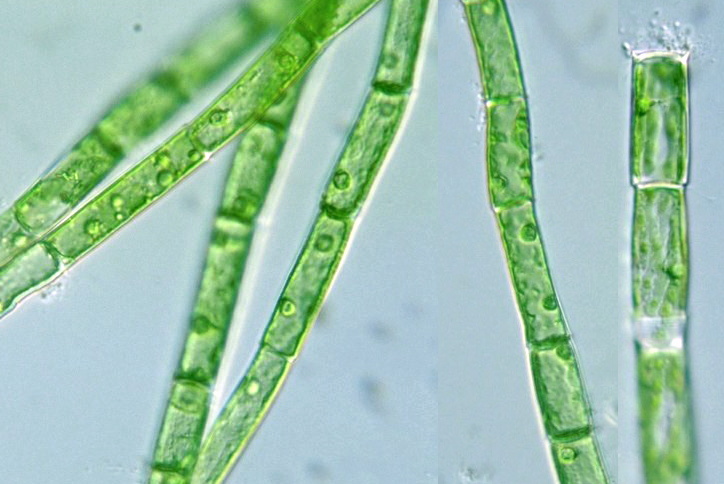
Oedogonium

Ulva spp.
Plant Reproduction
Powerpoint: Plant Reproduction Trends
- Define Alternation of Generation
- Describe the evolutionary trends of plant reproduction
One of the signature features of plants is that they reproduce via alternation of generations. Alternation of generations happen when in one complete life cycle, both asexual and sexual reproduction occurs. This is also accompanied by both haploid and diploid life stages.


In most plant life cycles (other than unicellular algae), there will be multicellular haploid and diploid stages.
We call the multicellular diploid stage the sporophyte. In ferns, gymnosperms and flowering plants, the sporophyte stages are the obvious stages. For example, the fern and trees are the sporophyte stage.
The purpose of the sporophyte:
- To produce spores via meiosis
- The spores, unlike the diploid multicellular stage are haploid
- To help the plant to disperse
The haploid spores will then duplicate to become the haploid, multicellular gametophyte.
The purpose of the gametophyte:
- To produce gametes (eggs and sperm) by mitosis
- These gametes can then be used for sexual reproduction.
- Sexual reproduction creates new combinations of genes that may produce new traits better suited to the environment. They also provide a better chance at least some may survive.
When the haploid gametes (N) fuse, they create a single diploid (2N) cell called a zygote. This zygote will then duplicate and become a multicellular diploid organism: the sporophyte.




